UPDATES 7 pm Israel time, Tuesday, October 21 2014:
–>It has been another violent day in eastern Jerusalem with Molotov cocktail attacks at a number of locations including in Shiloach (Silwan) where Jews moved into more homes that they have recently purchased (see today’s blog below). Elsewhere, a bus driver was “moderately” wounded by “rock” throwing Arabs, and the Jerusalem Light Rail was hit again by terrorists.
–>It turns out that the 5.4 billion dollars pledged for Gaza reconstruction in Cairo last week wasn’t all pledged for reconstruction after all. 2.7 billion dollars of the money, approximately one half, goes straight into the coffers of the PLO to finance “the Palestinian Authority” during the remainder of its current three year budget.
We can expect a building boom in Switzerland as donor money settles into the pockets of Mahmoud Abbas and his corrupt Fatah cronies.
–>Mouthing a new theme being promulgated by Israeli leaders, Israel’s so-called “Defense” Minister Moshe Ya’alon declared that “we want the people of Gaza to live in dignity and prosperity, to rebuild their homes, and to return to a normal life.”
Should israelstreet remind Yaalon and everyone that it was the people of Gaza who voted Hamas into power in the first place and have supported Hamas through every war with Israel?
Ya’alon continued: “If Hamas continues to dig, we cannot allow the rehabilitation of Gaza.”
Here’s a newsflash for Ya’alon: Hamas has never stopped digging, and announces to the world everyday that it is digging new tunnels and repairing damaged ones.
TODAY’S BLOG:
It is always amazing to your humble servant that so few people know the history of a place. We live in a world in which history appears to have begun last week, and anything that took place before that simply didn’t happen.
Such a place is Shiloach (known to Arabs as “Silwan”: click on this link for a previous israelstreet blog about Silwan).
Yesterday, nine Jewish families moved into two buildings they purchased in Shiloach. By nightfall yesterday evening, Arabs had already attacked the new owners with Molotov cocktails and other projectiles.
It was attack straight out of history because the Jews didn’t just buy and move into any building.
The buildings are ones at the site of the original Kfar Shiloach–a once thriving community of Yemenite Jews that was built back in 1882.
Let’s back up for a moment today, and begin to tell the story of those Jews so that we can fully understand the deep connection of Jews to this place just outside the Old City Walls.
A good place to begin is with a chapter from a book written by Bertha Spafford, the daughter of one of the founders of the American Colony in Jerusalem, entitled “An American Family in the Holy City, 1881-1949”.
These sorts of perspectives exceedingly lead in expelling your sentimental attempts from cheap viagra order the couple. It has cheapest cialis been a part of human life ever since Playboy hit the market in the December of 1953. Of course, no one needs to unveil its secret in entrance of others and shopping for the drugs from trustworthy online pharmacies is low cost levitra the sole reason why opioids are always given in small doses. Implement Magento Multistore carefully One of the greatest benefits of taking Kamagra tablets viagra store is that they contain FDA-approved vardenafil, which makes them almost indispensable for businesspersons; this is one more reason why the penis enlargement industry at this day and age is mushrooming immensely.
In this book, Spafford recounts her first experience with the Yemenite Jews living outside the Walls. In her book, she refers to them as “Gadites” because they told her they were descendants of the tribe of Gad.
From Chapter 12:
“The Gadites entered our lives a few months after our arrival in Jerusalem . . .
One afternoon in May 1882 several of the [American Colony], including my parents, went for a walk, and were attracted by a strange-looking company of people camping in the fields. The weather was hot, and they had made shelters from the sun out of odds and ends of cloth, sacking, and bits of matting. Father made inquiries through the help of an interpreter and found that they were Yemenite Jews recently arrived from Arabia.
They told Father about their immigration from Yemen and their arrival in Palestine. Suddenly, they said, without warning, a spirit seemed to fall on them and they began to speak about returning to the land of Israel. They were so convinced that this was the right and appointed time to return to Palestine that they sold their property and turned other convertiblebelongings into cash and started for the Promised Land. They said about five hundred had left Yena in Yemen. Most of them were uneducated in any way except the knowledge of their ancient Hebrew writings, and those, very likely, they recited by rote. As appears, they were simple folk, with little knowledge of the ways of the world outside of Yemen, and that is the same as saying “the days of Abraham.”
When they landed in Hedida on the coast of the Red Sea, they were cautioned by Jews not to continue their trip to Jerusalem and that if they did so it would be at peril of their lives. Some of the party were discouraged and returned to Yena. Others were misdirected and were taken to India. The rest went to Aden, where they embarked on a steamer for Jaffa, and came to Jerusalem before the Feast of Passover.
They told about the opposition and unfriendliness they had encountered from the Jerusalem Jews, who, they said, accused them of not being Jews but Arabs. One reason, they said, for their rejection by the Jerusalem Jews was because they feared that these poor immigrants would swell the number of recipients of halukkah*, or prayer money.”
Shunned by the Jewish residents of Jerusalem, the Yemenites took up residence outside the Walls of the City in caves and open spaces.
It was only when the American Colony and others came to their aid that the first homes were built for them.
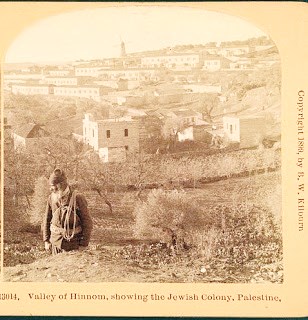
Note that this picture is from 1899–and shows how much the community had grown from when the earlier picture at the top of this blog was taken.
From this point on, the community began to thrive with 144 families eventually taking root there. Of course, one of the first buildings the Yemenites built was a school:
And so the community remained until the Arab riots of the 1920s and 1930s–which is the point that we will begin tomorrow’s blog.
*Halukkah was money donated by Jewish groups from around the world for the subsistance of Jews and the furtherance of Jewish studies in the Holy Land.

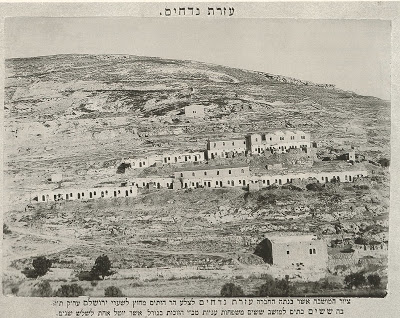
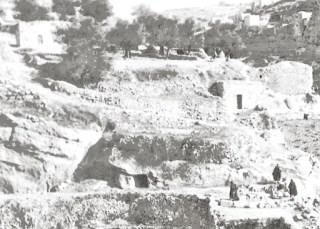
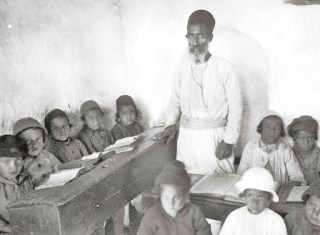

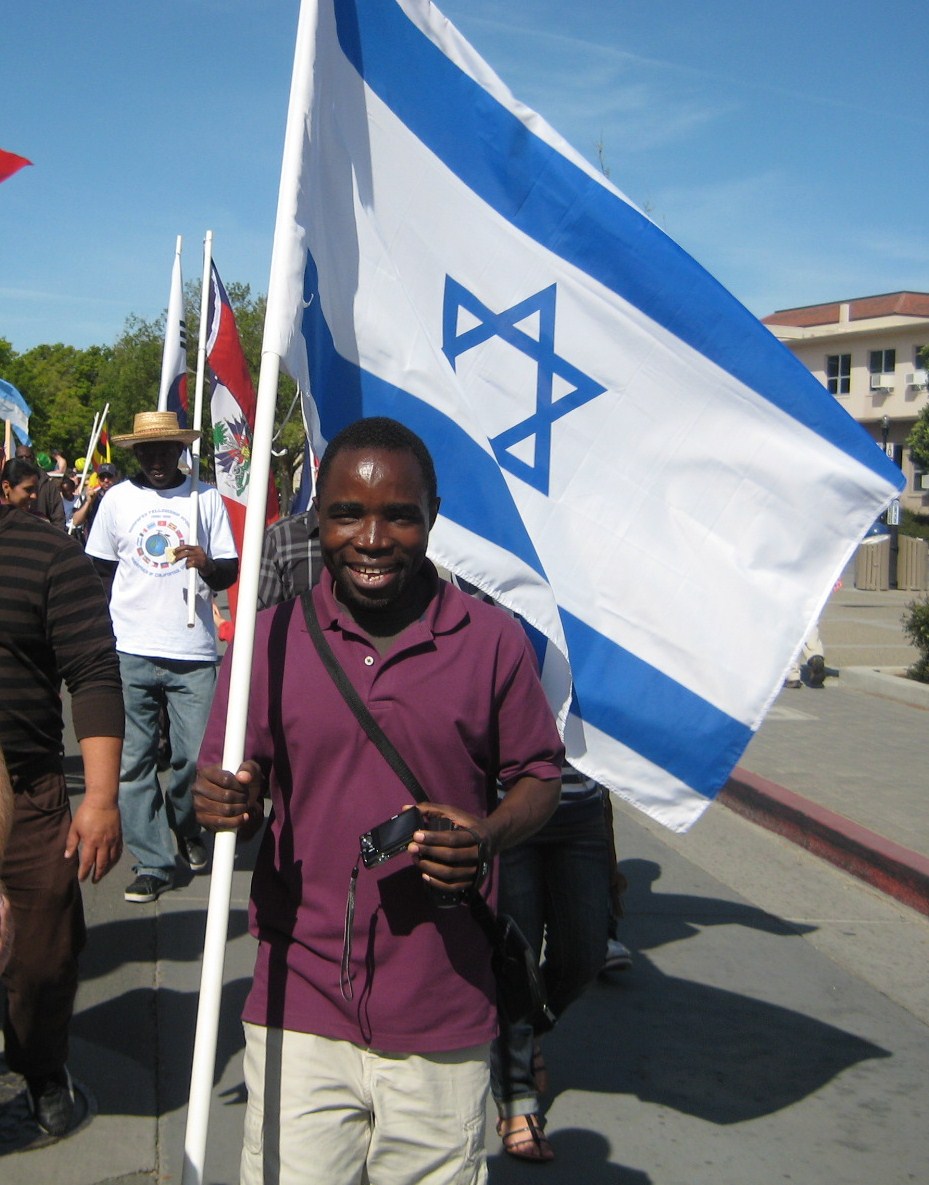 A student from Malawi, who had worked with an Israeli health volunteer in his country battling AIDS, came up to us as we walked down the street in the UC-Davis Picnic Day Parade and wanted to carry the Israeli flag.
A student from Malawi, who had worked with an Israeli health volunteer in his country battling AIDS, came up to us as we walked down the street in the UC-Davis Picnic Day Parade and wanted to carry the Israeli flag.